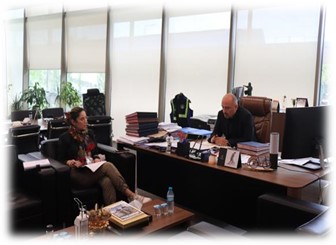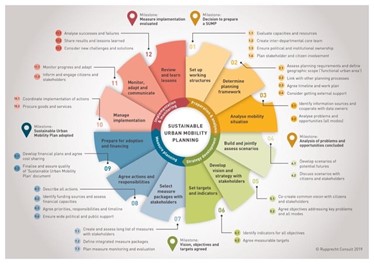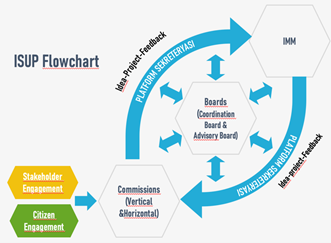Istanbul Transportation Platform explained
A series of interviews were conducted to overview the Istanbul Transportation Platform (ISUP). Deputy Secretary General İbrahim Orhan Demir, Head of Transportation Department Utku Cihan, and Member of ISUP Advisory Board Assoc. Prof. Eda Beyazıt İnce supported the project by contributing with their knowledge and experience on urban mobility at the stakeholders’ meetings as well as agreed to share their views on the ISUP and related topics.

|
Interview with İbrahim Orhan Demir, Deputy Secretary General of Istanbul Metropolitan Municipality The Sustainable Urban Mobility Planning Project (SUMP) is concluding by the end of 2021. Could you, please, elaborate, why the Istanbul Metropolitan Municipality (IMM) undertakes this kind of project? Transportation is a sector that affects all, including old, young, disabled, and children. Consequently, our main goal is to make the city more accessible, liveable, and resilient for all citizens. Our SUMP project is a master plan and guiding document, which illustrates the strategies that will allow us to realise these sub-scaled projects as the outputs of the SUMP. |
Are you conducting any transportation planning studies to achieve transportation vision in the near future? Can you tell us your main goals and strategies of these studies in consideration of this vision?
Shaped by the Istanbul SUMP project and funded by EU (85%) and IMM (15%) within the next year, we will have the IPA II Project, which aims to implement detailed and comprehensive projects, such as dedicated bus lanes and use of land in the city. There is an interaction between land use and transportation. If you change land use somewhere, you need to make an appropriate transportation infrastructure there and vice versa. If you build a strategically important transportation infrastructure somewhere, land use automatically changes.
The most important points in terms of wrong land use in Istanbul are, firstly, the increase of population density and expansion of the city through the North. Istanbul’s first large-scaled master plan was made in the 1980s scaled 1/50000. Till today all city plans, including the 1996’s plan scaled 1/100.000 and generated the idea of Istanbul’s linear enlargement in parallel with Marmara Sea by making subcentres in peripheral areas. This east-west axis enlargement aims to protect the North forests of Istanbul. We have a railway project titled in Turkish ‘Hızray Projesi’ (speed rail project) to avoid the enlargement through the North. The fastest metro line in Istanbul has a speed of 38 km/h and continues about 100 km, which takes 2 and half hours of journey from one end of Istanbul to the other. We need to speed up this journey and it should be aligned with the east-west axis. One of the solutions could be to make longer distances between stations, as the train is starting with 0 km/h then accelerates to the maximum speed, then again slows down and brakes. As much as you would assure a travel in maximum speed, you shorten the travel time. In fact, it looks like a flight, you fly from Istanbul to Ankara in almost 45 minutes, and in 1 hour to the City of Kars, even if Kars is 2 times away from Istanbul. Travel time does not rise in direct proportion to distance. Then, Istanbul-Kars doesn't take 45 multiplied 2 equal to 90 minutes, you need to take starting and braking phases into account with the distance as well. We will make a 3 or 5 km distance between two stations, so we could raise the speed up to 100 km/h. This project will help to change the land use in Istanbul according to the east-west axis enlargement planning, and people would live in peripheral areas instead of both centre and the North. At the same time, it will shorten travel time in Istanbul, the travel cost will decrease, economic value and time saved from transportation will rise.
|
During interview with İ. Orhan Demir |
What are the expected outputs/results of SUMP? SUMP’s main goal is to increase quality of life in the city, include the stakeholders into the policy process, decrease the use of private cars, and orient people to use environmentally friendly transportation systems. The main reason for all these efforts is to decrease the negative effects of climate change. We are aware that the main problem worldwide is climate change, not transportation. We have efforts based on regulation to fight back against climate change and projects to mitigate its results. In 2019, the mayor Ekrem Imamoğlu has signed the Deadline 2020 Agreement where we |
committed to make Istanbul resilient and carbon neutral by 2050. City of Istanbul is the only city which signed it. The Deadline 2020 Agreement followed the Paris Agreement on Climate Change, which is a legally binding international treaty and has recently been ratified by the Turkish Government to strengthen socio-economic resilience against climate change.
In addition to regulation activities, such as working together with C40 Cities, the Climate Action Plan and the Solid Waste Action Plan were revised, and the Noise Pollution Action Plan was elaborated. The Climate Action Plan was for the first time elaborated in such a big city as Istanbul and thus presented as good a practice to the C40 Cities’ network. IMM’s vision and its work are fighting against climate change and the Transportation Department is working aligned with this vision and the commitments.
What is your transportation vision at the city level, and what are the challenging areas, which you should to overcome? Please describe it regarding the national level, is there any liaison or/and disconnection between them?
As IMM, we have several bilateral relations with the central government. One of them is a legal link, which means we need confirmation for the projects, and the other one is an infrastructure issues, which means that intercity transportation infrastructure does not end at the city borders; it enters the city and affects. So, we naturally have corelation with the central government in terms of transportation. On the other hand, some transportation infrastructures are under the responsibility of the central government, such as TEM Highway and Bosporus bridges, ports and airports as well.
There are 3 types of integration in order for public transport to work well: firstly, seamless connections between different modes and lines; secondly, timetable interpretation, and finally, multiple validity of the tickets. So, the new system proposed by the Transportation Ministry would damage this integration as we need to work in cooperation with the central government, in order for urban transportation and intercity transportation to be planned together. All these should be gathered under a unique authority in a city, however, recently the a resilient integration structure in city’s transportation is under danger of being weakened.
What are the opportunities for both the local government and the Istanbul residents in the planning studies (relating to Istanbul SUMP project)?
The most important opportunity in Istanbul is enhancing more maritime transportation. What we need is to make it more accessible and preferable by residents. Firstly, we need to implement infrastructure that allows people to reach the seaside. Hisarüstü-Aşiyan Funicular project runs, and İTÜ- İstinye, Yıldız – Ortaköy and Altunizade- Beylerbeyi Funicular projects are in the tender and/or planning process. All these funicular projects aim to make a connection between metro stations and maritime transportation. Plus, there is also a sea taxi project in pipeline conceptualised to meet different public demand on maritime transportation.
A large percentage of people in Istanbul do not live near the seaside. We need to implement infrastructure that allows them to easily reach the sea axis. On the other hand, a maritime line parallel with the shore is not preferable because they are slower than road vehicles. Secondly, boats’ passenger capacity is high, so headways increase the waiting period as well. Lastly, it is not economically sustainable or environmentally friendly. We need an innovative design and engine, we succeeded with the sea taxi project as we can easily reach 25 knots with a small motor.
Can you describe your dream transportation / mobility system for Istanbul? What do you need to achieve this in the near future?
My dream transportation system for Istanbul incorporates Smart City solutions which decrease travel time. This will also include artificial intelligence technology and autonomous vehicles. In this way we could assure transportation optimization. The most important challenge to overcome is to regulate land use in accordance with decreasing travel time. For example, the proposition of the Mayor of Paris Hidalgo, is “the 15 minutes cities”. Time saving from travel can be used in other more useful fields such as education, art, or sport as well. This will create benefits on an individual as well as social, structural level. We could create holistic planning and implementation due to tools from smart city solutions and high-tech outputs. We know that Istanbul is a challenging city with its huge population and immense land use and these problems are rapidly intensifying. Our goal is to subvert these problems and make Istanbul a liveable city with its affordable, inclusive, seamless transportation structure.
Interview with Utku Cihan, Head of Transportation Department, Istanbul Metropolitan Municipality
What encourage
First, transportation projects are high budgeted projects
During the preparatory period of ISUP, we made 8 stakeholder meetings with
|
During interview with Utku Cihan |
Could you please The SUMP paradigm is a bit |
der the urban mobility umbrella, cities in the
Could you please
|
Source: https://www.eltis.org/mobility-plans/sump-process |
ISUP is a local level organisation that |
Can you describe the functioning of ISUP? What are the innovative components within the municipal management?
There is a two-way flow within the ISUP. A
What are the key contributions of Istanbul Transport Platform in supporting SUMP implementation?
|
The flowchart of the ISUP proposing at the launch, May 2021 |
What are your expectations and planning for the future of ISUP? A |
|
Many cities across the world are beginning to apply transportation policies which are human-oriented as opposed to car-oriented policies. SUMP is the strategy paper that shows our policy changes in transportation. What we need to do is to make people more mobile and make them use public transport and active mobility modes as well. By m aking public transport more comfortable, accessible, and preferable, we will be able to reverse upside down the traffic pyramid, which is dominated by cars, as putting the human at the top. This kind of transportation policy and practice are not familiar, but we will be applying this new approach to the city of Istanbul. In fact, the reason for abandoning old fashioned transportation planning and passing into sustainable urban mobility planning is exactly what we are focusing on; now we are focused on human mobility instead of cars . We established a couple of certain offices within the Transportation Department, one of them is Sustainable Urban Mobility Office which aims to make projects more inclusive and holistic by considering all mobility demands of all citizens. |
|
Pedestrian Chieftaincy and Bicycle Chieftaincy work towards promoting the active mobility modes in Istanbul, as well as implementing infrastructure and development projects to change mobility culture. Each of them is a living output of the SUMP project. In sustainable urban mobility planning we are focused on human, environment, participation, and we have strategies considering human mobilities . Our SUMP project will be ending by November 2021. After that we will implement another phase of SUMP in 2022, IPA II , funded by grant of 5.5 million Euro .
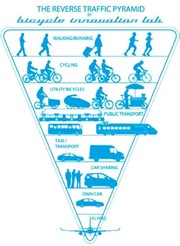
Source: https://www.researchgate.net/figure/The-reverse-traffic-pyramid-Source-Bicycle-Innovation-Lab_fig1_328748845
Interview with Assoc. Prof. Eda Beyazıt İnce, Member of ISUP Advisory Board
What is the main theme of SUMP? What
The main theme of SUMP is to improve the quality of life in the city with the development of the transport system in a sustainable manner in coordination with changes in the land use. SUMPs differ from conventional transport plans by emphasising the high level of participation and cooperation of stakeholders and citizens throughout the preparation and implementation of the plan. A SUMP considers the city beyond its administrative borders and connects with neighbouring cities and districts within its functional area. SUMPs also ensure the sustainability of the plans through a rigorous monitoring scheme with carefully designed indicators.
Our vision for the Istanbul SUMP is to realise ‘
In relation to this vision and to ensure its success, we have developed 9 main objectives. These objectives also lead to precise targets to achieve the SUMP vision for Istanbul.
|
The main objectives of SUMP:
|
Can you please
|
|
What ISUP is an open and inclusive platform where people |
transportation system more sustainable and liveable. Beyond these, discussions on developing solutions are important as well as
Do you know any examples
The best example that I could share with you is the
Can you describe
While ISUP is working with
SUMP is a strategic plan, and we know that some strategic plans would stay at the policy or strategic level without actualising the proposed actions. Of course, a strategic plan does not always aim to realise spatial interventions, but ISUP and IMM could carry out projects directly connected to the urban space such as running participatory processes with the public, place-making together with neighbourhood residents and businesses
Partner
Arup
Country
Republic of Turkey
City
Istanbul
Themes
Strategy & Planning
Mobility
Author(s)
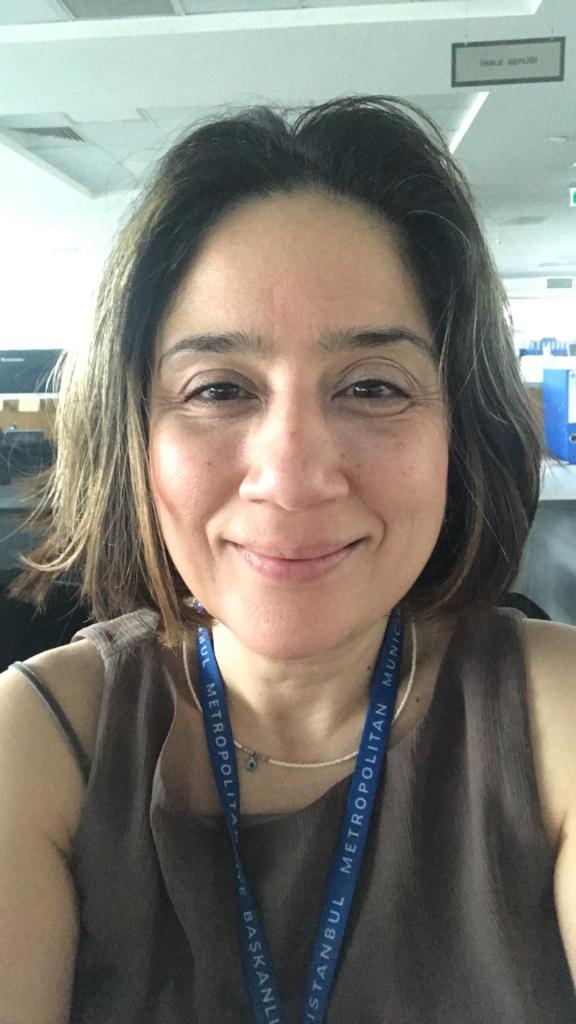
Şükriye Tümay Erdil
Project Manager at Sustainable Urban Mobility Office (SUMO), IMM Transportation Department, Transportation Planning Directorate, Istanbul Metropolitan Municipality

